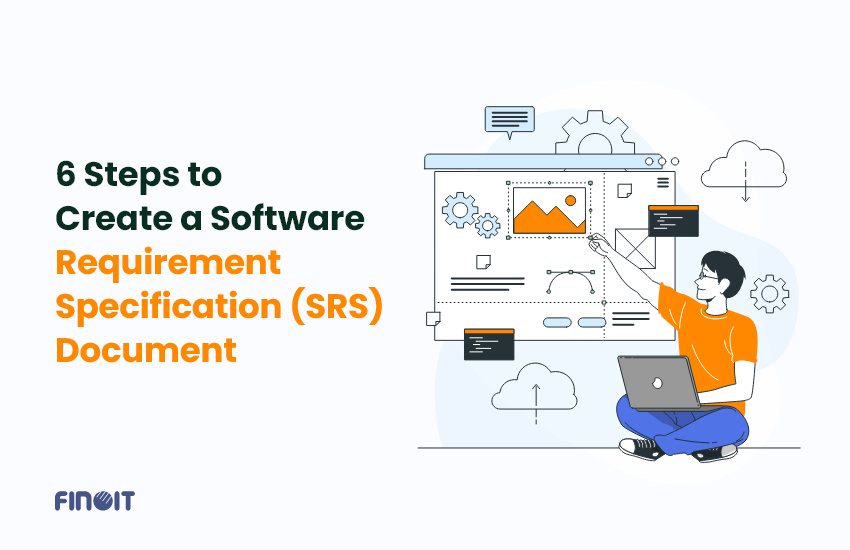Create a Software Requirement Specification (SRS) Document

An SRS is an effective tool for creating, organizing, and sharing your project requirements. It acts as a roadmap for the evolution of your project and reminds you of the purpose behind creating the product, the users to whom it will benefit, and its intended significance.
A Software Requirement Specification (SRS) Document essentially represents the essential features or “must-haves” for your product. Without these features, the software remains incomplete.
For example, many projects are completed within their allocated budget and timeline, with the support of an efficient team, but still they fail to create the impression they should have. The underlying reason for this outcome might be the absence of a Clear, Concise, and Executable Software Requirement Specification (SRS) document. A study by Project Management Organization reveals that approximately 70% of project failures are attributed to faulty requirements gathering. Additionally, poor requirement gathering for your software project escalates its cost and delays its lifecycle progress.
An SRS is a great way to create, organize, and share project requirements. But how do you create one? This blog will shed insight on creating a well-defined project requirement.
What is Software Requirement Specification Document (SRS)?
A Software Requirement Specification Document (SRS) is a vital component of the software development process. It serves as a comprehensive description of the software to be developed, providing detailed insights into the system’s purpose, functionality, interface, and performance criteria. It outlines various aspects of the software project, including:
- Purpose
The purpose section of the SRS document describes the software project’s overarching goal or objectives. It clarifies why the software is being developed and what problems it aims to solve. This section helps align the development team and stakeholders on the project’s ultimate mission, guiding decision-making throughout the development process.
- Functional Requirement
Functional requirements specify what the software should do. This includes a detailed description of features, capabilities, and behaviors expected from the software. Functional requirements outline specific actions users should be able to perform with the software and describe how the system should respond to various inputs. These requirements serve as the foundation for designing, building, and testing the software.
- Interface Requirements
Interface requirements detail how the software interacts with users, other systems, and external components. This includes user interface design specifications, such as screen layouts, navigation paths, and input mechanisms. It also covers integration points with other software systems, APIs, and hardware devices. Interface requirements ensure a seamless and intuitive user experience and define the boundaries of the software’s integration capabilities.
- Performance Criteria
Performance criteria define the standards and benchmarks the software must meet in terms of speed, scalability, reliability, and resource utilization. This includes metrics such as response times, throughput, system availability, and error handling. Performance criteria ensure that the software meets user expectations for responsiveness and efficiency under various operating conditions. It also guides performance testing efforts to validate the software’s performance against established criteria.
An SRS document is furthermore important in numerous ways as follows:
-
- Clarity and Communication
The SRS document serves as a common reference point for all project stakeholders. It ensures everyone has a clear understanding of the project scope, objectives, and requirements, fostering effective communication and collaboration among team members.
- Risk Management
By documenting requirements early in the development process, the SRS helps identify potential risks and challenges upfront. This allows the team to devise mitigation strategies and contingency plans to address risks proactively, minimizing the likelihood of project delays or failures.
- Guidance and Focus
The SRS document provides a roadmap for the development team, guiding their efforts and ensuring they remain aligned with the project’s objectives. It helps prioritize tasks, allocate resources effectively, and maintain focus on delivering the desired outcomes within the specified constraints.
- Cost and Time Savings
A well-defined SRS document helps prevent misunderstandings, scope creep, and rework during the development process. By clearly outlining project requirements and expectations, it reduces the likelihood of costly revisions and delays, ultimately saving time and resources.
- Optimal Requirement Definition
The process of creating an SRS involves thorough analysis and consideration of various factors, such as the software’s purpose, user needs, technical constraints, and business objectives. This helps in defining a comprehensive and optimized set of requirements that address the project’s core objectives while minimizing unnecessary complexity or ambiguity.
6 Steps to Create a Software Requirement Specification (SRS) Document
Step 1: Gather Preliminary Information
In the initial stages of creating a Software Requirement Specification (SRS) document, the first step involves gathering preliminary information through a structured approach. This process begins with understanding the scope of the project, which entails defining what is included and excluded from the software development endeavor. Clear delineation of boundaries is imperative to manage stakeholders’ expectations and prevent scope creep, ensuring that the project stays focused on its intended objectives. Understanding the scope also entails identifying the specific software solutions that the project aims to deliver, thereby aligning development efforts with overarching goals.
Another critical aspect of this step is stakeholder identification. This entails identifying all individuals or groups who have a vested interest in the project’s outcome, including clients, end-users, software engineers, and project managers. Recognizing the roles and responsibilities of each stakeholder is essential, as it helps determine their contributions to the software requirements specifications. Moreover, understanding the unique needs and perspectives of stakeholders is paramount, as it directly influences the software development requirements and ultimately shapes the project’s success.
Furthermore, the initial requirement-gathering phase involves employing various techniques to elicit requirements effectively. These techniques may include interviews, questionnaires, workshops, focus groups, and document analysis, each serving to uncover both explicit and implicit software requirements. Documenting the specific functionalities and system requirements identified during this phase is crucial to ensure comprehensive coverage and alignment with stakeholder needs. The foundation is laid for the subsequent steps in creating a well-defined and actionable SRS document by systematically gathering preliminary information in these key areas.
Step 2: Define the Purpose and Objectives
In the second step of creating a Software Requirement Specification (SRS) document, it is essential to define the purpose and objectives of the document clearly. This involves identifying the primary objectives that the SRS aims to fulfill, which include serving as a blueprint for both the development team and stakeholders. The SRS acts as a guiding document that ensures alignment on the requirements and expectations of the software project. By providing clarity and facilitating effective communication among all parties involved in the software development process, the SRS plays a pivotal role in minimizing misunderstandings and promoting collaboration.
Moreover, documenting the software solutions, specific functionalities, and system requirements examples in clear, concise, and actionable language is crucial. This ensures that all stakeholders have a comprehensive understanding of the project’s scope and what is expected from the final product. By articulating requirements in a precise manner, the SRS enables the development team to design and build the software effectively, meeting the desired objectives and user needs.
Additionally, aligning the project goals with overarching business objectives and user needs is paramount. Understanding these goals helps prioritize software development requirements and shapes the proposed software solutions accordingly. The process of setting specific, measurable, achievable, relevant, and time-bound (SMART) goals for the project ensures that objectives are well-defined and attainable. These goals should reflect both the desired outcomes of the software product and the criteria for its success, providing a roadmap for the development process and guiding decision-making at every stage.
Step 3: Detailed Requirements Analysis
The third step in creating a Software Requirement Specification (SRS) document involves conducting a detailed analysis of both functional and non-functional requirements.
- Functional Requirements
Functional requirements are specific behaviors or functions of the software system that outline what actions the system must perform to support users or stakeholders. This includes identifying core functions of the software, such as user interactions, data processing, and system operations critical to achieving the software’s objectives. Methods for gathering these requirements may include use cases, user stories, and requirement elicitation sessions, which help ensure that all necessary functionalities are identified and documented effectively.
- Non-functional Requirements
Non-functional requirements describe criteria that govern the operation of the system, focusing on aspects such as performance, usability, reliability, and security. Unlike functional requirements, which directly relate to business functions, non-functional requirements support the functionality of the system but do not perform these functions themselves. Various categories of non-functional requirements exist, including scalability, maintainability, compliance with industry standards, and adherence to security protocols. Identifying and documenting these requirements is essential for ensuring that the software meets not only functional expectations but also quality and performance standards, thereby enhancing user satisfaction and system reliability.
Step 4: Organize and Prioritize Requirements
Organizing and prioritizing requirements is a critical step in the software development process, aimed at making the development process more manageable and structured.
- Categorization
Categorization involves the process of grouping software development requirements into distinct categories. This step is significant as it helps in organizing and managing requirements effectively, facilitating a clearer understanding of the project scope. Various methods can be used for categorizing requirements, including dividing them into functional, non-functional, and domain-specific requirements. Additionally, tools and techniques such as requirement tagging and grouping are employed to streamline the categorization process, ensuring that all requirements are appropriately classified and documented.
- Prioritization
Prioritization is essential for allocating resources and focusing efforts on the most critical aspects of the project. It involves ranking requirements based on their significance, urgency, and impact on the project’s success. Several techniques can be employed for prioritizing requirements, including the MoSCoW method (Must have, Should have, Could have, Won’t have this time), numerical assignment (using scales such as 1 to n or High, Medium, Low), and the Kano model. These techniques help in making informed decisions about what features or functionalities to develop first, ensuring that the most valuable and essential requirements are addressed early in the development process. By prioritizing requirements effectively, development teams can optimize resource utilization, minimize project risks, and deliver software solutions that align closely with stakeholder needs and expectations.
Step 5: Specify and Model Requirements
In Step 5 of creating a Software Requirement Specification (SRS) document, the focus is on specifying and modeling requirements with precision and clarity.
- Clear Specification
Clear specifications are vital within the software development process, providing detailed and unambiguous descriptions of software functionality, system behaviors, and constraints. Effective specifications offer guidelines for writing concise, comprehensive, and understandable requirements, emphasizing clarity, completeness, and coherence. Standardized templates and language play a crucial role in achieving consistency across documentation, ensuring that all stakeholders interpret requirements uniformly.
- Use Cases and Diagrams
Use cases are employed to represent user interactions, scenarios, and system responses, aiding in visualizing requirements and identifying potential gaps or redundancies. Additionally, various types of diagrams, such as UML (Unified Modeling Language) diagrams, flowcharts, and ER (Entity-Relationship) diagrams, are utilized in software development. These diagrams provide a graphical representation of system architecture, data flow, and relationships, facilitating better understanding and communication among stakeholders.
- Review and Validation
The process of reviewing specified requirements and models with stakeholders, development teams, and end-users is crucial for verifying accuracy, feasibility, and completeness. These reviews ensure that requirements align with actual user needs and business objectives, minimizing the risk of misunderstandings or misinterpretations. Various techniques and approaches, including prototype testing, simulation, and use case walkthroughs, are employed for validating requirements. These validation methods play a pivotal role in ensuring that the finalized requirements effectively address user needs and contribute to the success of the software project.
Step 6: Finalize and Validate the SRS Document
Finalizing and validating the Software Requirement Specification (SRS) document is the culmination of the software development requirements gathering process.
- Review with Stakeholders
It is essential to engage all stakeholders in a final comprehensive review of the SRS document. This ensures that the document fully captures and accurately represents the software development requirements, encompassing both functional and non-functional aspects. A structured approach to reviewing the SRS document is recommended, involving methods such as review meetings, feedback sessions, and the use of collaborative tools. A systematic review process helps identify any discrepancies, ambiguities, or gaps in the SRS document, ensuring its completeness and accuracy.
- Incorporate Feedback
The process of incorporating feedback from the stakeholder review into the SRS document is iterative and dynamic. Given the evolving nature of software development requirements, it is crucial for the SRS document to evolve based on stakeholder input. This involves refining and updating the document to reflect feedback accurately. Clear, concise, and actionable modifications are essential to ensure that the SRS document remains a reliable blueprint for the software development process.
- Approval and Sign-off
Securing final approval for the SRS document from key stakeholders, including project sponsors, end-users, and development team leaders, is a critical step. This approval serves as a formal acknowledgment that the SRS meets all project requirements and expectations. The sign-off process may involve formal procedures or documentation required to officially finalize the SRS document, marking the conclusion of the requirements-gathering phase and the beginning of the software development lifecycle.


